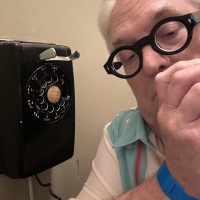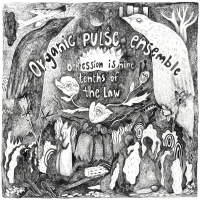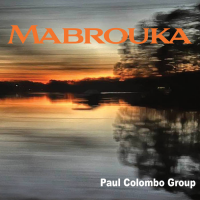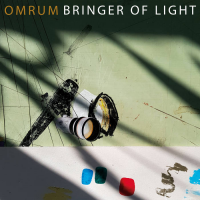Home » Jazz Articles » Album Review » Thelonious Monk: Les Liaisons Dangereuses 1960
Thelonious Monk: Les Liaisons Dangereuses 1960
When considering the enigma and iconoclast that is Thelonious Sphere Monk, one element of romance lay in any previously unknown recorded material. While Monk has been well documented, any new previously unheard or unreleased performances are worthy of attention and consideration. The last unheard Monk commercially released was Thelonious Monk Quartet with John Coltrane at Carnegie Hall (Blue Note, 1957, released 2005), and it caused a big stir at the time.
Likewise is the present diamond unearthed in a most circuitous way. It is not that one could not already hear the music presented on the Sam Records/Saga Records release Les Liaisons Dangereuses 1960; one could. The entire movie may be viewed here. Monk's contributions to the film have never been available as a stand-alone movie soundtrack. That is, until now. And, in that, there is a truly American story, clothed in a French chansone.
After the ends of World Wars I and II, many noted African-American jazz musicians (as well as other prominent African American artists) moved to France to practice their trade. Attracted by the comparative lack of racism, enhanced employment and recording opportunities, and the superior French appreciation for jazz, artists including Dexter Gordon, Bud Powell, Kenny Clarke, and Don Byas, as well as Lucky Thompson, Johnny Griffin and Arthur Briggs made their homes there abroad for long periods.
In the late 1950s, a group of young French movie directors sought out these and other African-American jazz artists to score the soundtracks for their films. These included Roger Vadim's Sait-On Jamais (1957) (We Never Know), renamed No Sun in Venice for which John Lewis wrote the score and his group, The Modern Jazz Quartet, performed. Marcel Carne's Les Tricheurs (Young Sinners) (1958) featuring performances by Oscar Peterson, Dizzy Gillespie, and Coleman Hawkins. Benny Golson scored Edouard Molinaro's 1959 Des Femmes Disparaissent (Women Disappear), performing the compositions with what may have been the best lineup of the The Jazz Messengers. And, perhaps the most famous jazz score to a film was that of Miles Davis who was picked to provide a score for Louis Malle's Ascenseur Pour L'Echafaud (Elevator to the Gallows) (1959). The use of jazz as a soundtrack was both forward thinking and sensible, foreshadowing the use of popular music in film and television soundtracks thereafter. I can only hear this use of period of jazz music as sound track as an adult, imagining of how it must has sounded 60 years ago. I call it thrilling. The use of jazz in the mentioned films acts a thread passed through these works, uniting them with something quintessentially fresh, American, exciting, a not just a little decadent.
Coming off his success with Sait-On Jamais, director Roger Vadim remained interested in using jazz as a movie score. Introduced to Monk's music by producer Marcel Romano, Vadim was immediately smitten and wanted Monk to provide a score for his new film Les Liaisons Dangereuses, based on the 18th-century epistolary novel written by Pierre Choderlos de Laclos. And this is where the story get interesting...and complicated.
The period surrounding Monk's recording Les Liaisons Dangereuses 1960, July 27, 1959, in New York City's Nola Penthouse Sound Studios was confounding in the respect that it is very well documented in the superb liner notes to the Sam Records/Saga release by notable personalities Laurent Guenoun, Alain Tercinet, and Monk biographer Robin D.G. Kelley, while still remaining historically murky in that Monk sort of way that all reportage about the pianist seems to be. This soundtrack session is not even included in the Jazz Discography Project where no July recording dates are detailed between a June 4th date in New York City that would result in 5 By Monk By 5 (Riverside, 1959) and an October 20th date in San Francisco that would eventually become Thelonious: Alone In San Francisco (Riverside, 1959).
It was a challenging and demanding period for the pianist. Monk's difficult circumstances began in October 1958 when he was arrested, and subsequently beaten by police, on a trumped-up drug charge, causing him to lose his cabaret card (an institutional racist ploy used to further marginalize black jazz musicians of the period) for the second time in the 1950s, the loss of which made it impossible for him to play in any New York City clubs. While a severe blow to Monk, at least emotionally, he did remain busy and in demand. The beginning of 1959 brought Monk a new rhythm section made up of bassist Sam Jones and drummer Art Taylor and had his manager Harry Colomby arranging a Town Hall concert featuring Monk's music arranged for big band. Riverside Records committed to release the concert, performed and recorded February 28th, eventually doing so as The Thelonious Monk Orchestra at Town Hall.
Monk had exhausted himself preparing the charts for this concert, which, once performed, received poor reviews, killing the possibility for a planned tour with the big band intended as a necessary revenue stream for the composer. The sum of Monk's arrest, his poorly received concert (which went on to become a recorded classic) and cancellation of this tour took its toll on the pianist, pushing him into a deep clinical depression, ultimately resulting in Monk's commission to the Grafton State Hospital after an agitated run in with police while he was performing at Storyville in Boston.
It was this Thelonious Monk who arrived at the Nola Penthouse Sound Studios that summer 1959, to record his music for the movie. The musical supervisor for the film, Marcel Romano, who had previously planned to have Monk come to Paris to record the score, had to abruptly change his plans when discovering Monk's travel restrictions due to his drug charge as well as Monk's recent commitment for psychiatric care. Romano had a thin timeline, requiring him in Paris with the music by July 31st. Five days prior to the drop-dead date, Romano found an anxious and exhausted man, suspicious of contracts but needing the money. Monk had composed no original music for the movie, instead entering the studio with his new rhythm section of bassist Sam Jones and drummer Art Taylor supplemented with the dual tenor front of Charlie Rouse and Frenchman Barney Wilen, and recording new arrangements of some of his best-known compositions, including the closest thing to a theme the film had, Monk's ballad "Crepuscule with Nellie." Other well-documented Monk tunes included his bouncing "Rhythm-a-Ning," the jaunty "Well, You Needn't," and Monk's love letter to his greatest benefactor, the Baroness Pannonica de Koenigswarter (née Rothschild), "Pannonica."
Monk's music was not the only jazz used in the film. Pianist Duke Jordan composed music for the film performed by the Art Blakey Jazz Messengers with the Barney Wilen. While this music is not considered "the score," it is incidental music with its proper place. Most specifically is the night club scene which features Jordan, Wilen, trumpeter Kenny Dorham, drummer Kenny Clarke and bassist Paul Rovère. Had Monk's tour not been cancelled, his would have been the featured quartet in the movie. The Duke Jordan material has been in release the past 60 years on Art Blakey and the Jazz Messengers' Les Liaisons Dangereuses 1960 (Fontana). There is considerable contrast between the two sets of performances that provide the film with a certain artistic tension.
French critics were chilly when writing of the film's score. As detailed in the excellent liner note by AlainTercinet, in one New Criticism spasm, French critic Jean-Louis Ginibre remarked in Jazz Magazine (1961), ..."but you can't talk about film music. On one hand there's the film, on the other, music." Taking this direction further and noting the lack of original material prepared by Monk, writer Henri Gathier noted in the movie issue of Premier Plan (1960), "the musicians do not seem to have been able to agree on the tone of the work as a film: they content themselves with playing the music that's familiar to them and tunes already in their repertoire. It's obvious that under these conditions, their performance remains too external, I'd even say indifferent to the film." That is just a nice way of saying Monk emailed in his contribution, which might have been plausible had Monk biographer Kelley not mitigated the circumstances by pointing out that Monk's reticence was due to a, "combination of caution and exhaustion. He was forty-one years old and had been cheated, underpaid, and exploited for much of his life...he was simply overcommitted, tired, and ill—not the best condition for writing new music."
All of this said, Monk's music, as performed, worked well in the film. Albeit, that judgement comes nearly 60 years after the debut of the film and, perhaps, by a film novice. The plot of Les Liaisons Dangereuses is one of gleeful amorality and decadence. Monk's music provides an interesting foil to the film themes by cutting its hedonism with a certain innocence not unlike having a dry wine to temper a rich meal. This point is further sharpened with the inclusion of two pieces not part of Monk's usual repertoire. The first was an improvised blues, "Six in One," untitled at the time, that would eventually emerge as "Round Lights" on Thelonious: Alone In San Francisco. The second was the cheekily selected spiritual "We'll Understand It Better By and By," which Monk chosen for juxtaposition against selected scenes in the film. Regarding Ginibre's postmodern statement regarding film music, Monk's score stands equally deserving comment whether as the score or a stand-alone performance. I believe it foolish not to consider this music as part of a film, adding to the depth and richness of the medium. As a stand-alone performance, I will point out the performance of "Well, You Needn't," as one of Monk's recorded best. This recording may be enjoyed whether experienced on the screen or the turntable.
There has recently been a spate of archival releases, all important and opportune, but Thelonious Monk -Les Liaisons Dangereuses 1960 is easily the greatest to date. I suspect the only way this release will be bettered is if someone uncovers and releases the apocryphal music of one Buddy Bolden.
Critic's Note: Anno Domini 2017, marks both the 100th Anniversary of recorded jazz, deftly noted by the release of the shellac "Dixieland Jass Band One-Step (A)/Livery Stable Blues (B)," Victor 18255, recorded February 26, 1917 and released March 7, 1917. My father was 18 months old and my mother was yet to be born for two years. It is also the twentieth anniversary of me writing for All About Jazz. The first recording I reviewed for the magazine was Art Pepper's San Francisco Samba (Contemporary, 1997), published December 1, 1997. I am using this present review as part of a series noting my twentieth anniversary with the magazine and paying special tribute to my fellow writers at All About Jazz and Publisher Michael Ricci.
Track Listing
CD1: Rhythm-a-Ning; Crepuscule with Nellie; Six in One; Well, You Needn’t; Pannonica (solo); Pannonica (solo); Pannonica (quartet); BaLue Boliver Ba-lues-Are; Light Blue; By and By. CD2: Rhythm-a-Ning(alternate); Crepuscule with Nellie (take 1); Pannonica (45 master); Light Blue (45 Master); Well, You Needn’t (unedited); Light Blue (making of).
Personnel
Thelonious Monk
pianoThelonious Monk: piano; Charlie Rouse: tenor saxophone; Barney Wilen: tenor saxophone; Sam Jones: bass; Art Taylor: drums.
Album information
Title: Les Liaisons Dangereuses 1960 | Year Released: 2017 | Record Label: Sam Records
Tags
PREVIOUS / NEXT
Support All About Jazz
 All About Jazz has been a pillar of jazz since 1995, championing it as an art form and, more importantly, supporting the musicians who make it. Our enduring commitment has made "AAJ" one of the most culturally important websites of its kind, read by hundreds of thousands of fans, musicians and industry figures every month.
All About Jazz has been a pillar of jazz since 1995, championing it as an art form and, more importantly, supporting the musicians who make it. Our enduring commitment has made "AAJ" one of the most culturally important websites of its kind, read by hundreds of thousands of fans, musicians and industry figures every month.























